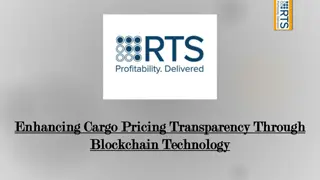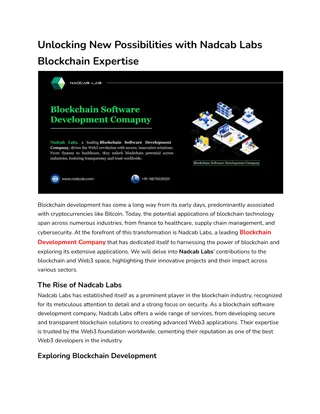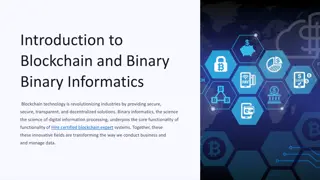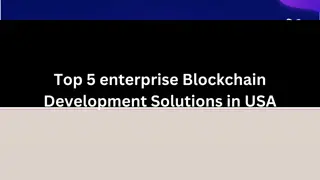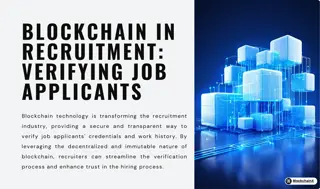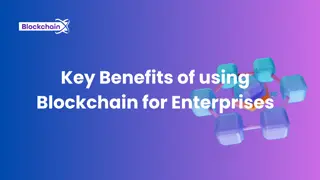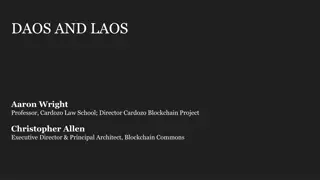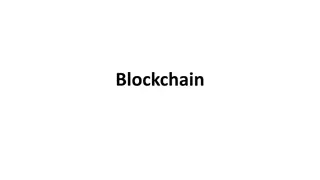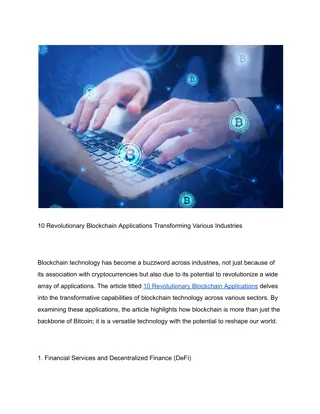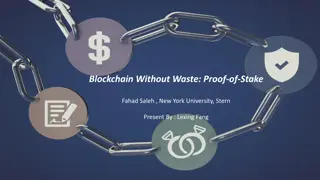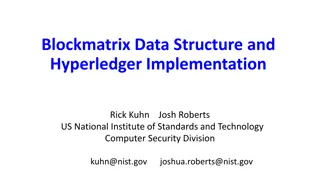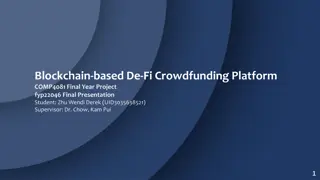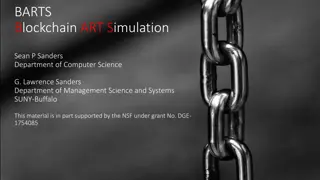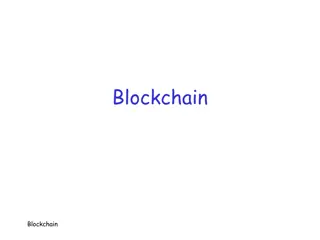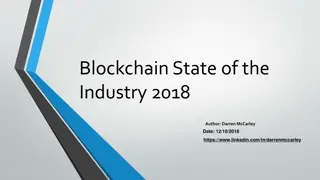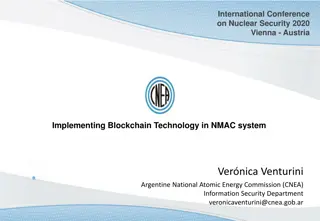Business Impacts of Blockchain Technology
This learning unit delves into the disruptive potential of blockchain technology on existing business models. It examines real-world use cases across various industries and discusses the implications, challenges, and merits of implementing blockchain. Topics include regulatory considerations, blockchain's impact on business innovation, and analyzing SWOT factors in industry scenarios.
Download Presentation

Please find below an Image/Link to download the presentation.
The content on the website is provided AS IS for your information and personal use only. It may not be sold, licensed, or shared on other websites without obtaining consent from the author.If you encounter any issues during the download, it is possible that the publisher has removed the file from their server.
You are allowed to download the files provided on this website for personal or commercial use, subject to the condition that they are used lawfully. All files are the property of their respective owners.
The content on the website is provided AS IS for your information and personal use only. It may not be sold, licensed, or shared on other websites without obtaining consent from the author.
E N D
Presentation Transcript
BLISS Project Output O3 Open Education Resource Task O3-T1 Training and assessment material U3 Communicating the business merits, challenges and implications of blockchain technology Learning unit : 50 Hours : Introduces how the characteristics of blockchain technology can disrupt and/or innovate existing business models and business processes. Examines existing blockchain-based use cases in industries such as finance, public services, provenance, supply chains etc. Abstract : 2
Communicating the business merits, challenges and implications of blockchain technology U3 Learning unit Learning outcomes Interpret the legal, regulatory and consumer challenges to wider blockchain adoption and conformance K5 Knowledge Skills Policy and regulation Recognise potential regulatory and legal frameworks for blockchain operation, including consumer protection, and taxation Blockchain and Public Policy, Central Banks & governmental regulations Implications of blockchains for governments, policy makers, law professionals, regulators and society 3
Communicating the business merits, challenges and implications of blockchain technology U3 Learning unit Learning outcomes Monitor the intervention of blockchain technology in business models K6 Knowledge Skills Blockchain as innovator of businesses and processes Provide detailed examples of the blockchain transforming power in specific contexts Blockchain business models Blockchain emerging trends susceptible to create value for the business Innovative blockchain solutions and entrepreneurship Blockchain transforming business and professionalism 4
Communicating the business merits, challenges and implications of blockchain technology U3 Learning unit Learning outcomes Analyse blockchain SWOT (Strengths, Weaknesses, Opportunities, Threats) for specific industry scenarios K7 Knowledge Skills Blockchain maturity and strategies Project strengths and weaknesses of the Blockchain technology in a given scenario Blockchain adoption metrics, challenges and opportunities Blockchain business strategies 5
Communicating the business merits, challenges and implications of blockchain technology U3 Learning unit Learning outcomes Intelligibly present Blockchain industry business models K8 Knowledge Skills Blockchain as business model disruption Describe blockchain business processes and business logics Implications of blockchains for corporates, such as disruption by open markets, winner- takes-all, multi-sided market platforms, the role of trust in blockchain markets How blockchain technology is disrupting existing business models and creating new ones 6
Communicating the business merits, challenges and implications of blockchain technology U3 Learning unit Learning outcomes Communicate business opportunities behind the limits of the blockchain K9 Knowledge Skills Existing applications Outline latest trends in the blockchain technology, and the directions of growth across impacted industries Main disruptive features of different practical blockchain application scenarios, such as in finance, assurance, accounting, business operations, public administration and government services 7
U3 : Communicating the business merits, challenges and implications of blockchain technology Fr d rique Biennier INSA of Lyon, France 8
Table of Contents Part 1: Promoting Blockchain usage From traditional economy to digital economy Blockchain context New business models or new technologies for existing business models? Exercises Part 2: Value models Traditional value models Characterizing a blockchain value system Building the Blockchain value model Integration of blockchain value models in digital economy collaborative business Exercises 9
Table of Contents: PART 1 From traditional economy to digital economy Blockchain context New business models or new technologies for existing business models? Exercises 10
According to you, how can you qualify the digital economy? Are there any models qualifying the business environment? What are the main collaborative ecosystems models? Which requirements can be fulfilled using a blockchain? 11
According to you, how can you qualify the digital economy? In this part you will Learn basic elements on digital economy and collaborative ecosystems Learn how IT and blockchain technologies have evolved to fit the economic context Get information on collaborative ecosystem requirements and how blockchain technology can be an answer 12
Table of Contents: PART 1 From traditional economy to digital economy Business model IT evolution Collaborative ecosystems Requirements for blockchain support Blockchain context New business models or new technologies for existing business models? Exercises 13
Business model: Value Characterizing value: Aggregating one or more impacts Financial, social impact, environmental impact, cultural impact Global organization Internal How to produce the product / service o Identification of the main costs related to investments as well as functioning costs o Relationships with partners / competitors How value is shared o How to be more attractive than competitors o 14
15 Business model: Business environment (1) Red Ocean (Porter 1980) Highly competitive environment Well known demand Value measured in monetary units How to survive: differentiated or cheaper product / service Blue Ocean (Kim and Mauborgne 2002) Highly innovative industry New demands and markets Value is measured in monetary units How to survive: creating a new product and the associated market 15
16 Business model: Business environment (2) Purple Ocean Mixing both Red and Blue ocean strategy Value measured thanks to monetary units How to survice: identify innovations to get market advantage Green Ocean Integrating sustainability and environmental impact in the value New demand for green products Sustainability is a driver for innovation Black ocean Closing market to competitors to reduce risks regarding the investments Unfair/unethical advantages to survive 16
17 Business model: Blockchain market Disruptive technology New demand for distributed trust management Distributed and opened applications Core mining function Highly competitive market Red Ocean strategy Blockchain based development Mixing both innovation and strong competition Blockchain appears as a differentiation mean Private / semi-private blockchain may be used to close the market 17
Table of Contents: PART 1 From traditional economy to digital economy Business model IT evolution Collaborative ecosystems Requirements for blockchain support Blockchain context New business models or new technologies for existing business models? Exercises 18
19 IT Evolution: Architecture evolution (1) Centralized Distributed Years 60-70 Years 80-90 Main cost related to hardware Microprocessor => PC o o Repetitive tasks Main cost related to the software o o File system / centralized DB o Relational DB with interoperable query language o Years 90-2000 Main costs related to the software configuration o Years 2000-2010 SOA o ERP => Standard software o Web technologies o Centralized organization to support distributed decision o More adaptive systems o Cloud => outsourcing and industrialized organisation o 19
20 IT Evolution: Architecture evolution (2) SMAC IT revolution? Front end / back end organization Different accesses o Social media Mobile vs traditional systems Extend the collaboration requirements o Generalized XaaS model Pay per use o On demand o Data are seen as value due to analytical processes Extend the service and distributed application challenges 20
21 IT evolution: requirements (1) Years 60 - 70: Programing is an art! High ownership costs Development of languages, databases, files systems Industrial organization of IT production. First attempts towards multi-media Years 80 - 95 Relational databases -> openness provided by SQL Object Oriented Programing Software packages and on the shelf offers First step to industrialize of software production 21
22 IT evolution: requirements (2) Years 95 / 2000 Large scale software packages Minor purchasing costs Major parametrization costs o o Proprietary environments Framework development Start industrialize software production environment Now Communication costs decrease Middleware logics Pay per use Open source software development Mutation towards a service-oriented environment o Increase the call for Distributed Transaction management 22
23 IT evolution: Network environment Internet architecture Built incrementally in the 70 P2P organization Few application oriented services Telcos vision Rather prospective => OSI model Integration of several service features such as interoperability, synchronization management, application service organization Web-based technology Extend the Internet stack use P2P organization Extended connectors to deploy collaborative business 23
Table of Contents: PART 1 From traditional economy to digital economy Business model IT evolution Collaborative ecosystems Requirements for blockchain support Blockchain context New business models or new technologies for existing business models? Exercises 24
25 Collaborative ecosystems: collaborative organisation Partner centered collaborative organization Main stakeholder and its related business partners Mid-term to long-term collaboration Centralized vision Centralized business network Main stakeholder with its business partners Networked value chain thanks to transversal relationships between partners Take advantage of trust developed using the partner centered collaborative organization Semi-decentralized vision Fully decentralized Based on the business development and on the client own value chain Require developing trust Need to interconnect trusted Business Process (BP) in a short-term / mid-term vision 25
26 Collaborative Business: Requirements Various requirements Standard process description for Business processes (best practices, legal constraints) Example of the SCOR patterns used in the Supply chain o Expending partner centered organization to e-marketplace Increase the competition between potential partners o Selection / cooptation to join the trusted e-marketplace o Integration of IoT / WoT information to share production process information Adding new process models o Enriching partners interactions o 26
27 Collaborative Business: collaboration strategy Informal collaboration Based on trust P2P co-operation No common processes Contract-based collaboration Activities are coordinated thanks to a common process but Information Systems (ISs) are not integrated Contracts support partners interaction Trust is enforced by the contractual relationship Fully integrated cooperation Cooperating legacy IS requiring interoperability Common process with strong interactions between partners own processes Multiple contracts management 27
28 Collaborative Business: collaborative BP Trust management Key point to set collaborative organization Depends on various criteria Human relationships o Non functional properties related to cost, delay, quality o Supervision and governance functions Necessary to monitor agreements (SLA and business agreements) Requires integrating agreements related to different transaction Organizing the common process Is not a simple composition of each partner own process Requires managing IS interoperability Activity imputability 28
29 Collaborative Business: legal constraints Value-added process management involves paying attention to Responsibility limits Financial flows Main requirements Electronic Data Interchange Standard interoperable documents o Transaction log management o Interchange contracts reporting IS interactions o Trusted parties certification Legal accreditation o Certification process o Different legal contexts for international collaboration 29
Table of Contents From traditional economy to digital economy Business model IT evolution Collaborative ecosystems Requirements for blockchain support Blockchain context New business models or new technologies for existing business models? Exercises 30
31 Blockchain-based collaboration: requirements Trust between partners Authentication: being sur of the identity of the contracting parties Reputation: knowing what has been done before is necessary for cooptation Transparency: each partner can control what others are doing to reach the common goal Transaction management P2P and multi-tiers contractual relationships and transactions Ledgers are necessary to fulfill legal obligations so that transactions can be tracked Automating Business Transaction Identifying intermediaries involved in the common process Tracking IS interactions Integration and synchronization of various components 31
32 Blockchain-based collaboration: Blockchain characteristics Digital and distributed ledgers storing signed transactions Transactions are stored in blocks and blocks are chained Double-spending mechanism Shared ledgers increase availability and reduce fraud risks Digital signature provides integrity and imputability Increased transparency (but no confidentiality) Extra services Smart contract allowing event-based process organization Digital identity providing certified authentication process Multiple signature mechanisms 32
33 Blockchain-based collaboration: benefits Transparency Recorded transactions Need to define precisely the transaction information Collaborative network management Identity certification Cooptation process registering Distributed BP Record processes interactions Identify launching conditions for each sub-process 33
Table of Contents: PART 1 From traditional economy to digital economy Blockchain context Blockchain key principles Blockchain characteristics Hype cycle New business models or new technologies for existing business models? Exercises 34
According to you, how can you qualify a blockchain project? Is there only one kind of Blockchain project or several kinds of blockchain? How to set a blockchain typology? What are the main components? Is Blockchain only a buz word or can its hype cycle be characterized? 35
According to you, how can you qualify the digital economy? In this part you will Learn basic elements on blockchain characteristics to set a typology Identify key elements to select a convenient blockchain support Get information on blockchain hype cycle 36
Table of Contents: PART 1 From traditional economy to digital economy Blockchain context Blockchain key principles Blockchain characteristics Hype cycle New business models or new technologies for existing business models? Exercises 37
38 Blockchain key principles: Previous works Time-stamped information Digital signature including a time-stamp (1991) Use hashing techniques Merkle tree (1979) Store hashed information Binary tree organization Merging blocks involves computing new hash associated to the father node Strong cryptographic foundation but How can the Merkle tree be stored How to protect it from attacks 38
39 Blockchain key principles: characteristics From transaction to blockchain A block stores transactions data o The previous block hash o A Merkle tree stores the blocks Each block is signed with a hash o Decentralized storage of the Merkle tree Distributed ledgers Safer storage o Common governance rule How to trust the block validation process o 39
40 Blockchain key principles: governance rules Proof of Work (PoW) Block s hash is computed according to a mathematical challenge Finding the nonce in a bruteforce way o Requires important computing resources and energy Trust depend on the hardware investment and on the consumed computing resources o Proof of Stake Validator is randomly chosen according to the invested currency Avoid heavy computation Involves less speculation o Proof of Authority List of potential certified validators Reputation mark 40
Table of Contents: PART 1 From traditional economy to digital economy Blockchain context Blockchain key principles Blockchain characteristics Hype cycle New business models or new technologies for existing business models? Exercises 41
42 Blockchain characteristics: access control Permissionless blockchain Opened and shared ledgers Free access for validators Users are identified by their avatar Public blockchain Permissioned blockchain Authorized validators Restricted access to the ledgers Users are associated to well known identities Used for private blockchain / consortium blockchain 42
43 Blockchain characteristics: architecture (1) Similar to the Cloud stack model Source: https://www2.deloitte.com/content/dam/Deloitte/in/Documents/industries/in-convergence-blockchain-tech-stack-noexp.pdf May lead to Blockchain as a Service organisation 43
44 Blockchain characteristics: architecture (2) Infrastructure Computing, communication and storage features Mining process Adapted hardware o Optimized cryptographic computation o Organisation and protocols Blockchain platform Validation strategy Consensus method Services End user wallet system Trusted services: identity management, distributed files/DB, event manager, digital asset management 44
Table of Contents: PART 1 From traditional economy to digital economy Blockchain context Blockchain key principles Blockchain characteristics Hype cycle New business models or new technologies for existing business models? Exercises 45
46 Blockchain hype cycle Blockchain3.0: Smart contracts + IoT Blockchain2.0: Smart contracts Blockchain 1.0 46
47 Blockchain hype cycle: Blockchain 1.0 key elements First introduced as Bitcoin Fiat currency P2P currency transfer without intermediaries But it requires miners! o No valuable good exchange to support the crypto-currency Transaction validation Solve the double spending problem Fees Use the blockchain token o Miners choose the best transactions to integrate into blocks o Paid only if the block is validated o 47
48 Blockchain hype cycle: Blockchain 1.0 limits Long delay (10 minutes for a bitcoin block validation) Scalability problem Identity management Identity related to a key No proven links between the real identity and the avatar Security risks Internal byzantine fault Lossing private key Crypto-currency No legal status for the tokens Crypto-currency isolation: no exchange mechanisms between different currencies Highly volatile value due to speculation of the main actors 48
49 Blockchain hype cycle: Blockchain 2.0 key elements First implementation in Ethereum Smart contracts Distributed application Contract based organization Event driven Integrates the transaction payment Distributed application Open-source Manage its own tokens Automated transaction execution Data and operations are stored in the blockchain 49
50 Blockchain hype cycle: Blockchain 2.0 limits Smart contract legal status Computarized transaction and not a contract How parties identity can be proven? How to be sure of the capacity of the contracting parties? Different regulations depending on the hosting countries Event driven organization Allows reactivity Different organization than the traditional control driven logic Code is law Code cannot be adapted even in case of failure Increased security risks Blockchain delay and scalability? 50


